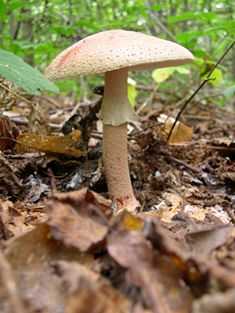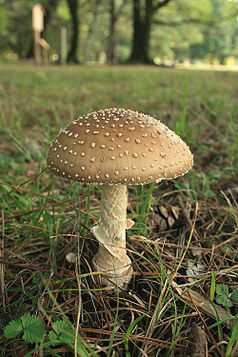Blusher
| Blusher | |
|---|---|
 | |
| Conservation status | |
| Very common | |
| Scientific classification | |
| Kingdom: | Fungi |
| Division: | Basidiomycota |
| Class: | Agaricomycetes |
| Order: | Agaricales |
| Family: | Amanitaceae |
| Genus: | Amanita |
| Species: | A. rubescens A. novinupta |
| Binomial name | |
| Amanita rubescens (Pers. ex Fr.) Gray | |
| Amanita rubescens and allies' | |
|---|---|
|
| |
| gills on hymenium | |
| cap is flat | |
| hymenium is free | |
| stipe has a ring | |
| spore print is white | |
| ecology is mycorrhizal | |
| edibility: choice | |
The Blusher is the common name for several closely related species of the genus Amanita. A. rubescens, found in Europe and eastern North America, and A. novinupta in western North America. Both their scientific and common names are derived from the propensity of their flesh to turn pink on bruising, or cutting. Although edible, it can be confused with deadly poisonous species, and should definitely be avoided by novice mushroomers.
Description
The European blusher has a reddish-brown convex pileus (cap), that is up to 15 cm across, and strewn with small cream-coloured warts. It is sometimes covered with an ochre-yellow flush which can be washed by the rain. The flesh of the mushroom is white, becoming pink when bruised or exposed to air. This is a key feature in differentiating it from the poisonous False Blusher or Panther cap (Amanita pantherina), whose flesh does not. The stipe (stem) is white with flushes of the cap colour, and grows to a height of up to 15 cm. The gills are white and free of the stem, and display red spots when damaged. The ring is striate (i.e. has ridges) on its upper side, another feature distinguishing it from Amanita pantherina. The spores are white, ovate, amyloid, and approximately 8 by 5 µm in size.
The flavour of the uncooked flesh is mild, but has a faint acrid aftertaste. The smell is not strong.
The mushroom is often attacked by insects.
Distribution and habitat
It is common throughout much of Europe and eastern North America, growing on poor soils as well as in deciduous or coniferous woodlands. It has also been recorded from South Africa, where it is thought to have been accidentally introduced with trees imported from Europe.[1]
Amanita novinupta
A species found in the western U.S., only recently formally described and until then frequently misidentified as A. rubescens; see MykoWeb - Fungi of California - Amanita novinupta for details.
Other species
Closely related species include Amanita brunneolocularis, A. orsonii, A. rubescens var. alba, and A. rubescens var. congolensis.[2]
Uses
Both of these species are edible when cooked. European Amanita rubescens is known to contain a hemolytic poison in its raw state; it is unknown whether North American A. rubescens and A. novinupta are similarly toxic in its raw state. This toxin is destroyed by cooking.
Amanita novinupta is highly regarded as a choice edible in the region in which it is found. However, the edibility of blusher species other than A. rubescens and A. novinupta has not been established and experimentation is not advised.
-

Amanita amerirubescens
-

Amanita amerirubescens
-

mushrooms at various ages
See also
References
- ↑ Reid DA, Eicker A (1991). "South African fungi: the genus Amanita" (PDF). Mycological Research 95: 80–95. doi:10.1016/S0953-7562(09)81364-6. Retrieved 2007-11-13.
- ↑ http://pluto.njcc.com/~ret/amanita/species/brunlocu.html
External links
| Wikimedia Commons has media related to Amanita rubescens. |
- "Tabular and Nontabular Keys to the Rubescent Species of Amanita section Validae" by Rodham E. Tulloss, March 10, 2003.
Amanita rubescens
- "Amanita rubescens" by Michael Kuo, MushroomExpert.Com, March 2003.
- "Amanita rubescens Pers.:Fr." by Rodham E. Tulloss, June 25, 2006.
Amanita novinupta
- "Amanita novinupta" by Michael Kuo, MushroomExpert.Com, March 2003.
- "Amanita novinupta Tulloss & J. Lindgr." by Rodham E. Tulloss, July 25, 2006.
- "Amanita novinupta" by Michael Wood & Fred Stevens, MykoWeb, 2004.
Other species
- "Amanita brunneolocularis Tulloss, Ovrebo & Halling" by Rodham E. Tulloss, October 6, 2006.
- "Amanita flavorubens (Berk. & Mont.) Sacc." by Rodham E. Tulloss, July 25, 2006.
- "Amanita flavorubescens" by Michael Kuo, MushroomExpert.Com, September 2002.
- "Amanita orsonii A. Kumar & T. N. Lakh." by Rodham E. Tulloss, July 25, 2006.
- "Amanita rubescens var. alba Coker" by Rodham E. Tulloss, July 25, 2006.
- "Amanita rubescens var. congolensis Beeli" by Rodham E. Tulloss, July 25, 2006.
| |||||||||||||||||||||||||||||||||||||||||||||||||

